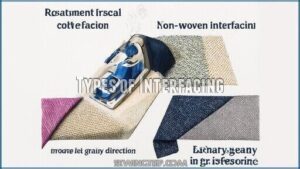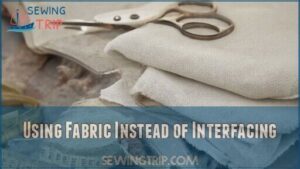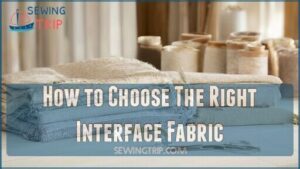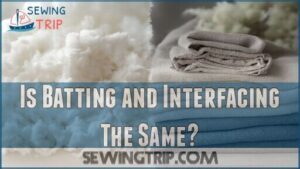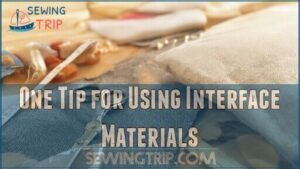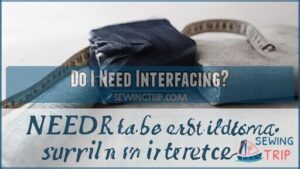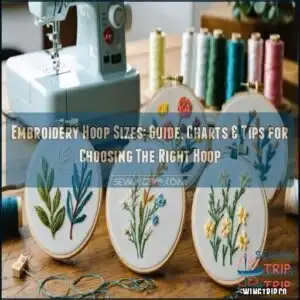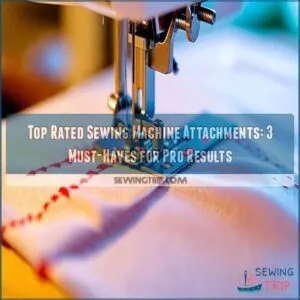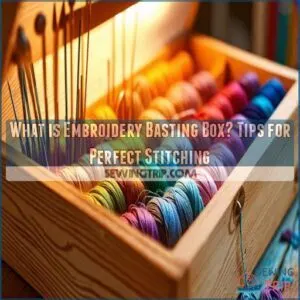This site is supported by our readers. We may earn a commission, at no cost to you, if you purchase through links.
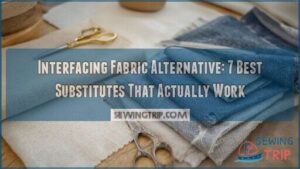 You’re looking for an interfacing fabric alternative, and you’ve got options.
You’re looking for an interfacing fabric alternative, and you’ve got options.
Muslin, broadcloth, linen, canvas, denim, and twill can all work as substitutes, depending on your project’s needs.
When choosing an alternative, consider the weight and drape of your main fabric, and test the substitute first.
This way, you’ll guarantee a great finish.
Now, let’s explore these alternatives in more detail, and you’ll discover which one works best for your next sewing project, and what other tips you can use to achieve professional-looking results.
Table Of Contents
- Key Takeaways
- What is Interfacing in Sewing?
- Importance of Interfacing
- Types of Interfacing
- Using Fabric Instead of Interfacing
- Best Interfacing Fabric Alternative
- How to Choose The Right Interface Fabric
- How to Attach Fusible Interfacing
- Is Batting and Interfacing The Same?
- One Tip for Using Interface Materials
- Do I Need Interfacing?
- Frequently Asked Questions (FAQs)
- Conclusion
Key Takeaways
- You’ll want to choose an interfacing fabric alternative that matches your project’s needs, considering the weight and drape of your main fabric, and test it first to guarantee a great finish.
- When selecting a substitute, you should consider factors like fabric weight, grain matching, shrinkage control, and layering fabrics strategically to achieve the desired stiffness levels.
- You can use various fabrics like cotton, muslin, linen, or silk as substitutes for interfacing, and even double up your main fabric for consistency, depending on the project’s requirements.
- To ensure professional-looking results, you should pre-shrink your interfacing fabric alternative, match the weight to your main fabric, and choose neutral colors to prevent show-through, and always test for hand feel and drape before cutting.
What is Interfacing in Sewing?
Interfacing in sewing acts as your fabric’s backbone, providing essential garment structure and fabric stabilization where you need it most.
Interfacing is your fabric’s backbone, providing structure and stability where needed most
This sewing support material bonds to the wrong side of your fabric using heat or stitching, creating professional sewing results without visible bulk.
Think of interfacing fabric as your project’s foundation.
It transforms flimsy collars into crisp, structured elements and prevents pocket corners from sagging over time.
The magic happens through fabric stiffening that maintains your garment’s intended shape while preserving natural drape.
When searching for interfacing fabric alternatives, you’ll want materials that offer similar sewing supplies functionality.
The right substitute provides edge finishing support without compromising your fabric’s character.
Whether you’re working with delicate silks or sturdy cottons, proper fabric stabilization guarantees your handmade pieces look professionally constructed.
Smart sewers test their chosen alternatives on fabric scraps first, verifying the bond strength and flexibility match their project’s demands for lasting, beautiful results.
Importance of Interfacing
Proper fabric support transforms amateur sewing into professional garments. Without interfacing or suitable alternatives, your carefully crafted pieces will disappoint you. The fabric loses its intended shape, buttons pull awkwardly, and collars droop instead of standing crisp.
Smart sewers understand that interfacing fabric alternatives can enhance durability just as effectively as commercial products. These substitutes prevent sagging while helping maintain shape throughout the garment’s life. Whether you’re working on shirt collars or jacket lapels, the right fabric reinforcement creates that coveted professional finish. Matching fabric weight is essential for balance.
Consider these fabric stiffening benefits:
- Reinforce fabric areas that experience stress during wear
- Provide structural support for buttonholes and pockets
- Stabilize edges for clean, lasting construction
- Add body without compromising the garment’s natural drape
Garment construction depends on strategic fabric support placement, making interfacing alternatives valuable skills for any sewing enthusiast. This understanding is key to creating garments that look and feel professional and have a long-lasting quality, making the effort to learn about fabric support worthwhile.
Types of Interfacing
Understanding interfacing types helps you make smart choices for your sewing projects.
You’ll encounter three main categories that each serve different purposes.
Fusible vs Sew-in interfacing affects your application method.
Fusible interfacing bonds with heat and pressure, while sew-in requires hand or machine stitching.
Both offer reliable results when properly applied.
Non-woven interfacing provides excellent non-woven durability without grain direction concerns.
This interfacing substitute works well for most projects since you can cut it in any direction.
It’s your go-to fabric alternatives choice.
Woven interfacing contains woven grain direction that must align with your fabric’s grain.
This type offers natural drape but requires careful cutting and placement.
Knit interfacing uses include stretch fabrics where flexibility matters.
It moves with your fabric while providing structure.
Weight and drape considerations matter most when selecting types.
Light interfacing preserves fabric flow, while heavy versions add substantial structure.
Match your interfacing fabric alternative weight to your project’s needs for professional results.
Using Fabric Instead of Interfacing
When you’re caught without traditional interfacing, regular fabric can step up as your backup plan.
Many sewers discover that fabric alternatives work just as well as store-bought options.
You’ll want to select fabric that matches your project’s needs without creating unwanted bulk or stiffness.
The key lies in understanding how different fabrics behave when used as interfacing substitutes.
Consider these essential factors when choosing fabric alternatives:
- Fabric weight should complement your main material without overpowering it
- Grain matching guarantees proper drape and prevents unwanted pulling or distortion
- Shrinkage control through pre-washing prevents future garment issues
- Layering fabrics strategically can achieve desired stiffness levels
- Cost comparison often favors fabric substitutes over commercial interfacing.
Cotton, muslin, and linen make excellent fabric stiffener options.
These fabric stiffening solutions offer reliable support while maintaining your garment’s natural feel.
Test your chosen fabric substitutes on scraps first to confirm compatibility with your main fabric.
Best Interfacing Fabric Alternative
Foam Stabilizer’s ability to turn floppy fabric into a sturdy masterpiece has earned it a spot as a top interfacing fabric alternative.
It’s a true sewing stabilizer—easy to stitch through and reliable for both beginners and seasoned crafters.
If you’re after versatility, Fuse-N-Shape Heavyweight White Fabric packs a punch with its dual-sided fusibility and knack for strengthening everything from bag bottoms to hat brims.
Don’t overlook simple options like iron-on adhesive, light muslin fabric, synthetic fabric interfacing, or even a trusty scrap of cotton—all can stand in as practical fabric substitutes.
Understanding how interfacing balances stiffness and flexibility is key to a successful project. Hence, it’s important to know how interfacing provides structure.
When choosing your interfacing substitute, pay close attention to Weight Considerations and Drape Compatibility to make certain a smooth finish.
Always perform Shrinkage Testing to sidestep unwanted surprises.
Remember, Cost Comparison and Availability Factors are equally important so you don’t break the bank while giving your projects lasting structure with the right fabric stiffener.
How to Choose The Right Interface Fabric
Nearly every sewing project benefits from taking extra care when picking the right interfacing fabric or interfacing substitute. Start by matching the fabric weight; using one that’s lighter or the same weight as your main fabric avoids odd stiffness or lumpy seams.
Think about your project type—are you working on a cozy shirt, a crisp collar, or a rugged bag? Desired stiffness also matters; aim for enough support without turning your garment into cardboard. For projects needing a soft lining, consider using fleece interfacing options for bags and cases.
Finally, color considerations and hand feel come into play—neutral shades blend best and the fabric should feel smooth, never scratchy. To ensure the best results, remember to:
- Match interfacing fabric weight to your main fabric
- Choose neutral colors to prevent show-through
- Test for hand feel and drape before cutting
- Select stiffness based on your project’s needs
How to Attach Fusible Interfacing
You’re about to discover the secrets of attaching fusible interfacing. To start, preheat your iron to the recommended temperature and test it on a scrap fabric.
- Use the right pressing technique to avoid bubbles and wrinkles, ensuring a smooth finish with your fusible interfacing or iron on interfacing.
As you work with fusible interfacing, remember to keep in mind cooling time and fabric protection to achieve professional results, and explore alternatives like an interfacing substitute for unique projects, all while maintaining alignment accuracy and mastering the art of ironing with fusible materials. Many resources discuss products for interfacing.
Is Batting and Interfacing The Same?
You’re wondering if batting and interfacing are the same. They’re not.
Here’s a comparison:
| Property | Batting | Interfacing |
|---|---|---|
| Purpose | Insulation | Stability |
| Thickness | Varying | Lightweight |
| Suitability | Quilts, padding | Garments, bags |
| Cost | Varied | Generally low |
Batting has unique properties, making it unsuitable as an interfacing substitute. Interfacing provides structure, while batting offers loft and warmth.
Choose the right one for your project, considering thickness, suitability, and cost.
One Tip for Using Interface Materials
When using interface materials, you’ll find that pre-shrinking is key to preventing distortions.
Try basting your fabric substitute before permanently attaching it to guarantee proper positioning.
Weight matching and grain alignment are also essential for a seamless finish.
Testing adhesion and fusing temperature will help you achieve the perfect bond.
As an interfacing substitute, consider fabric alternatives like sewin interfacing or fusible interfacing.
By following these tips, you’ll be able to create professional-looking projects with ease, making the most of your interfacing fabric alternative.
This will give you the freedom to explore various sewing avenues and drive innovation in your craft.
Do I Need Interfacing?
You’re considering whether you need interfacing for your sewing project, and understanding its purpose is key.
Interfacing adds structure and stability to your fabric, so you’ll need to decide if it’s necessary for your specific project to achieve the desired outcome.
How Do You Stiffen Fabric Without Interfacing?
You can stiffen fabric without interfacing by using natural stiffeners like starch alternatives or layering fabrics.
Try DIY stiffening methods, such as applying a cornstarch and water mixture, for a temporary fix.
This technique serves as a viable interfacing substitute, providing fabric stiffness without chemical treatments, and is a useful DIY method.
Can I Use a Stabilizer as Interfacing?
You consider a stabilizer as an interfacing fabric alternative.
It offers durability and support.
Here are its benefits:
- Improves longevity
- Enables size adjustments
- Provides acetate coatings
- Offers foam choices
- Troubleshoots issues, making it a viable substitute in sewing, especially when choosing between stabilizer types and interfacing fabric alternatives.
What is a Substitute for Interfacing?
You’ll often find fabric alternatives like cotton, muslin, or linen serve as substitutes for interfacing fabric, offering a fabric weight match and considering shrinkage, grainline importance, and substitute durability.
While being cost-effective solutions for your sewing projects, these alternatives provide a viable option for those looking to save money without compromising on quality.
Frequently Asked Questions (FAQs)
What Can I Use if I Don’t Have Any Interfacing on Hand?
While lacking interfacing, you can substitute it with cotton, muslin, or linen, which provide stability and structure, allowing you to complete your project with a polished finish.
Is There a Vegan or Eco-friendly Alternative to Traditional Interfacing?
You can use eco-friendly alternatives like organic cotton, hemp, or recycled fabrics as a substitute for traditional interfacing, offering a sustainable and vegan option for your sewing projects.
How Do I Store Interfacing Properly to Prevent It From Getting Damaged?
You store interfacing in a dry, cool place, away from direct sunlight, to prevent damage and maintain its quality, ensuring it remains stable and effective for your sewing projects.
Are There Any Common Mistakes to Avoid When Working With Interfacing?
You’ll want to avoid common mistakes like uneven cutting, insufficient pre-shrinking, and improper fusion when working with interfacing to guarantee a polished, professional finish.
What’s the Best Way to Press Interfacing So It Fuses Evenly?
You’ll press interfacing evenly by preheating your iron, using a press cloth, and applying gentle pressure with an up-and-down motion to avoid shifting layers.
What can you use instead of interfacing fabric?
You can substitute cotton, muslin, linen, or silk for interfacing. Double up your main fabric for consistency. Canvas works for heavy-duty projects, while silk organza provides lightweight structure.
How do you stiffen fabric without interfacing?
You can stiffen fabric using spray starch, liquid starch, cornstarch solution, or sugar water. Apply evenly, let dry, then press with heat to set the stiffening agent permanently.
What can be used for interfacing?
You can use cotton, muslin, linen, silk, canvas, felt, or your main fabric as interfacing alternatives. Each provides different levels of structure and support for your sewing projects.
Can you use another layer of fabric instead of interfacing?
You can double your main fabric as an interfacing alternative, ensuring a cohesive look by matching grain and weave for a polished finish.
What can I use if I don’t have any interfacing on hand?
You can try using another layer of fabric, like cotton or muslin, as a substitute to add stability and structure to your project, it’s a handy alternative.
Conclusion
You’ve mastered the art of finding an interfacing fabric alternative, now apply it.
Choose a substitute that matches your project’s needs, considering weight and drape, and test it first.
This guarantees a great finish, and you’ll be a pro at using interfacing fabric alternatives in no time, making your sewing projects stand out with the right interfacing fabric alternative.


